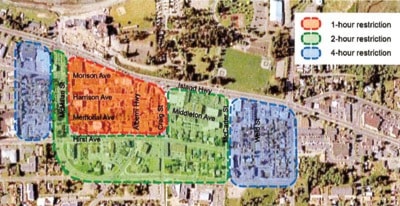The name might be Parksville, but parking could become an issue if the city doesn’t take some steps.
According to a delayed Downtown Core Parking Study, occupancy rose from 65 to 73 percent during the peak hour over just two years while some areas hit 84 percent and city owned lots reach 100 per cent full at their peak.
On-street public parking is plentiful, but the study points to a problem with the city’s four off-street public lots being near capacity.
“There is clear and convincing evidence we are lacking in off-street parking in the downtown core,” said director of engineering and operations Robert Harary.
While councillors discussed anecdotal evidence of whether it’s hard to park downtown, the data indicates that things are fine now but need some planning for the future.
The Boulevard Transportation Group report was submitted to council with a 37 item implementation schedule ranging from simple educational and policy adjustments, to more capital intensive suggestions like purchasing new lots and implementing pay parking.
The good news, Harary said, is that the report doesn’t call for on-street metered parking in the foreseeable future, though it does suggest nominal rates ($3/day) for off-street public lots in the next few years, mostly to encourage people to find other easy options.
It points out that no parking is free, it’s just a question of whether the user pays directly or the community subsidizes it through taxes.
The report says that downtown businesses are the main problem, not providing enough parking for employees, who use the convenient and free city lots rather than walking, biking, car-pooling, or paying for parking elsewhere.
The study focuses on the 790 public spaces in the downtown core, touches on 490 additional spaces in Community Park and nearby residential streets and mentions 1,200 private spots in private lots.
It suggests a long-term approach, starting with simple items like encouraging people to park a bit farther away and/or using alternate transportation.
Harary pointed out that 71 percent of respondents to a survey included in the study said it was acceptable to walk two or three blocks to their destination and in every case of a full city parking lot there are plenty of rarely used spaces within three blocks.
It found people are generally happy with parking in the city, with 58 percent saying there is enough.
There was initially some discomfort among councillors who thought they were being asked to support all 37 recommendations, until it was made clear they where just accepting the report for information and staff would start working through individual items as time and funds allowed. Any substantial changes will come back for council approval.
The study is actually the result of two portions after the first draft was submitted in November 2009 at the height of engineering and operations staff shortages.
The draft report was shelved until Harary requested updated details last September. The total cost of the study was $46,680, including $5,000 for the update.
Staff estimates the capital projects would cost more than $2 million and council was clear they are not eager to embark on the more expensive items in the foreseeable future.
